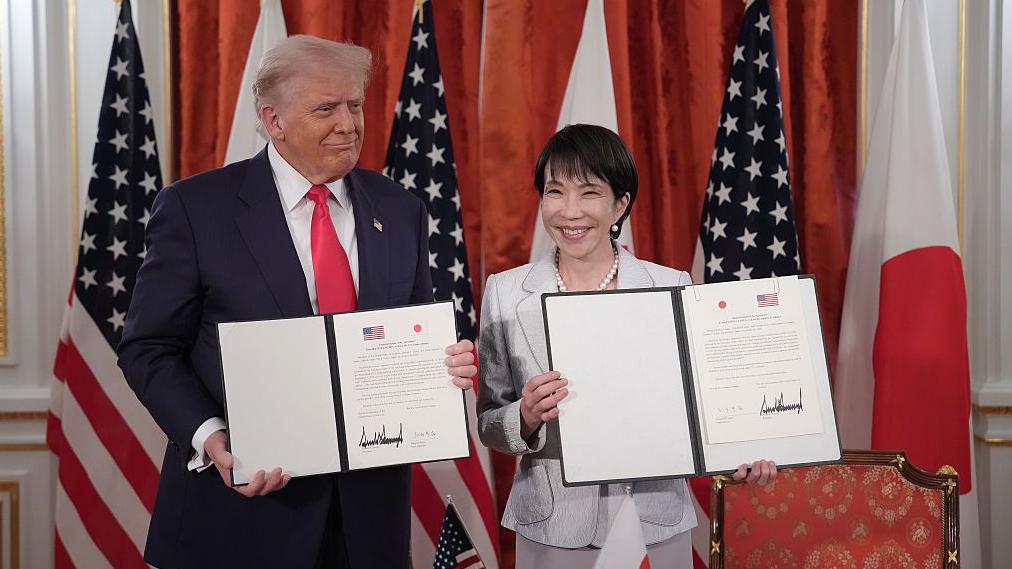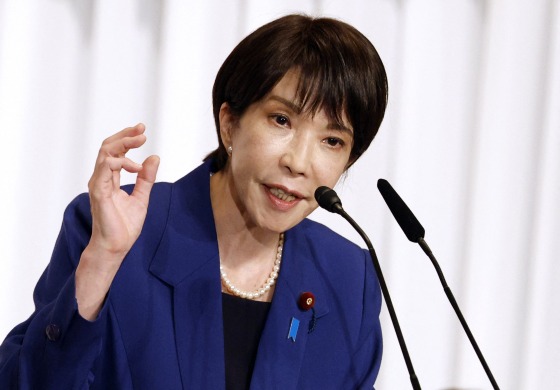Japanese PM Takaichi and Trump forge a ‘Golden Age’ alliance amid global power shifts

Trump and Japanese PM Takaichi seal Japan–U.S. ‘Golden Age’ pact. Image Source: Getty Images
Donald Trump’s visit to Tokyo marked a turning point in U.S.–Japan diplomacy as Japanese Prime Minister Sanae Takaichi welcomed him with full state honors and a clear message: Japan is ready to enter a “new golden age” of alliance with the United States.
At the Akasaka Palace, where gold-trimmed walls mirrored the grandeur of the occasion, the two leaders signed a sweeping agreement on rare earth minerals, a move that signals Tokyo’s intent to deepen economic and strategic ties with Washington amid a volatile global landscape. For Trump, the visit was an affirmation of his “America First” vision abroad, and a chance to rekindle the chemistry that once defined his partnership with former Japanese leader Shinzo Abe.
Mutual Praise, Strategic Promises
Takaichi, Japan’s first female prime minister, praised Trump as a “partner in a new golden era” and pledged to nominate him for the Nobel Peace Prize, a symbolic gesture that underscored her alignment with the U.S. president’s global agenda. Trump, in turn, hailed her leadership, calling her a “close friend” and promising that “anything Japan needs, America will deliver.”
Their conversation ranged from defense cooperation to trade and energy resilience, culminating in the rare earths deal that both framed as a win for industrial independence. For Japan, the pact promises access to critical materials vital to its tech and auto sectors. For Trump, it represents another front in his long-running economic rivalry with China, which dominates the global rare earth supply chain.
READ ALSO
A Delicate Balancing Act for Japan
Behind the optics of friendship lies a delicate balancing act for Prime Minister Takaichi. She inherits a complex diplomatic landscape, strengthening ties with Washington while managing Tokyo’s deep economic dependence on Beijing. Her challenge is to reinforce Japan’s security posture without igniting regional tensions.
The two leaders’ joint statement committed both nations to “economic security and shared prosperity,” but analysts note that Takaichi must tread carefully between U.S. strategic expectations and Japan’s domestic constraints. The influential farming lobby, wary of expanded U.S. agricultural imports, remains a key political concern, as do Japan’s auto exporters who suffered steep tariff losses under earlier trade disputes.
Echoes of Abe, Signals to Beijing
Trump’s rapport with Takaichi mirrors his past camaraderie with the late Shinzo Abe, a mentor to the new prime minister. The emotional resonance was clear when Trump invoked Abe’s legacy, calling him “one of the best.” By presenting Trump with Abe’s personal golf putter, Takaichi reinforced a continuity of friendship and policy that bridges Japan’s conservative leadership lineage.
Yet, the symbolism also carried a strategic undertone. As China tightens its grip on rare earth exports, the U.S.–Japan deal sends a clear signal to Beijing: the alliance remains economically and militarily aligned. Takaichi’s pledge to “fundamentally reinforce Japan’s defense” adds another layer to that message, especially as Trump confirmed new U.S. missile deliveries for Japan’s F-35 fighter jets.
The Golden Age, or Strategic Necessity?
While Takaichi and Trump celebrated their partnership aboard the USS George Washington, analysts observed that this “golden age” is as much about necessity as optimism. With China asserting itself in the Pacific and U.S. influence shifting under Trump’s second term, Tokyo’s diplomatic moves appear both pragmatic and preemptive.
As Trump continues his Asia tour, bound for South Korea and a potential meeting with Xi Jinping, Japan’s renewed alliance offers him a vital geopolitical win. For Takaichi, it’s a high-stakes start to her premiership, defining Japan’s position at the crossroads of global power.
FAQ: Japanese PM and Trump
Who is Japanese Prime Minister Sanae Takaichi?
Sanae Takaichi is Japan’s first female prime minister, known for her conservative policies, admiration for Shinzo Abe, and commitment to strengthening Japan’s defense and global partnerships.
What is the new “Golden Age” deal between Japan and the U.S.?
It’s a strategic agreement signed by Trump and Takaichi to enhance cooperation on rare earth minerals, defense, and economic security, positioning both nations as stronger allies amid global competition.
Why is the rare earth deal important to Japan and the U.S.?
The deal reduces dependence on China for critical minerals used in technology and defense, creating a more resilient supply chain for both nations.
Did Sanae Takaichi nominate Donald Trump for the Nobel Peace Prize?
Yes. During Trump’s visit, Takaichi announced her intention to nominate him, citing his efforts to promote peace in regions such as the Middle East.
How does the U.S.–Japan alliance affect China?
The strengthened partnership sends a strategic signal to Beijing, indicating that Japan and the U.S. are deepening military and economic coordination in response to China’s growing regional influence.


